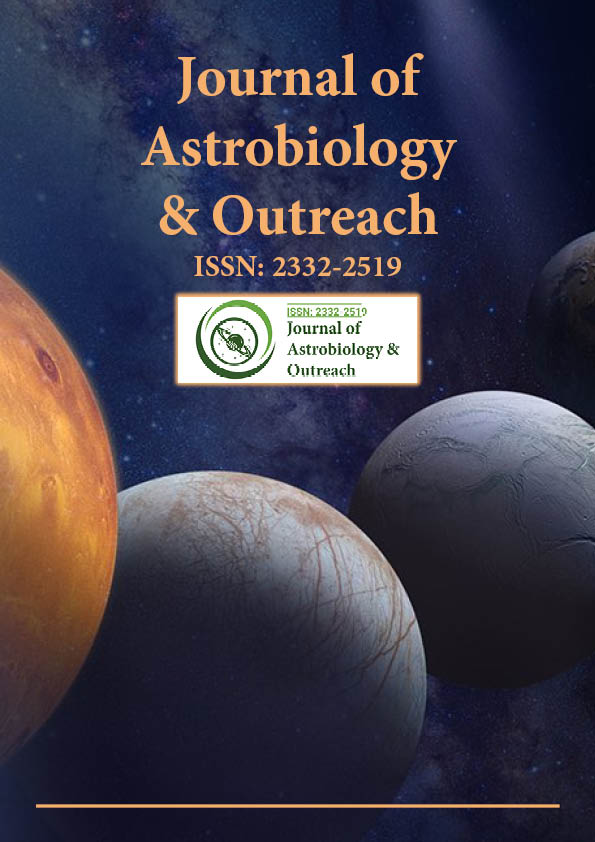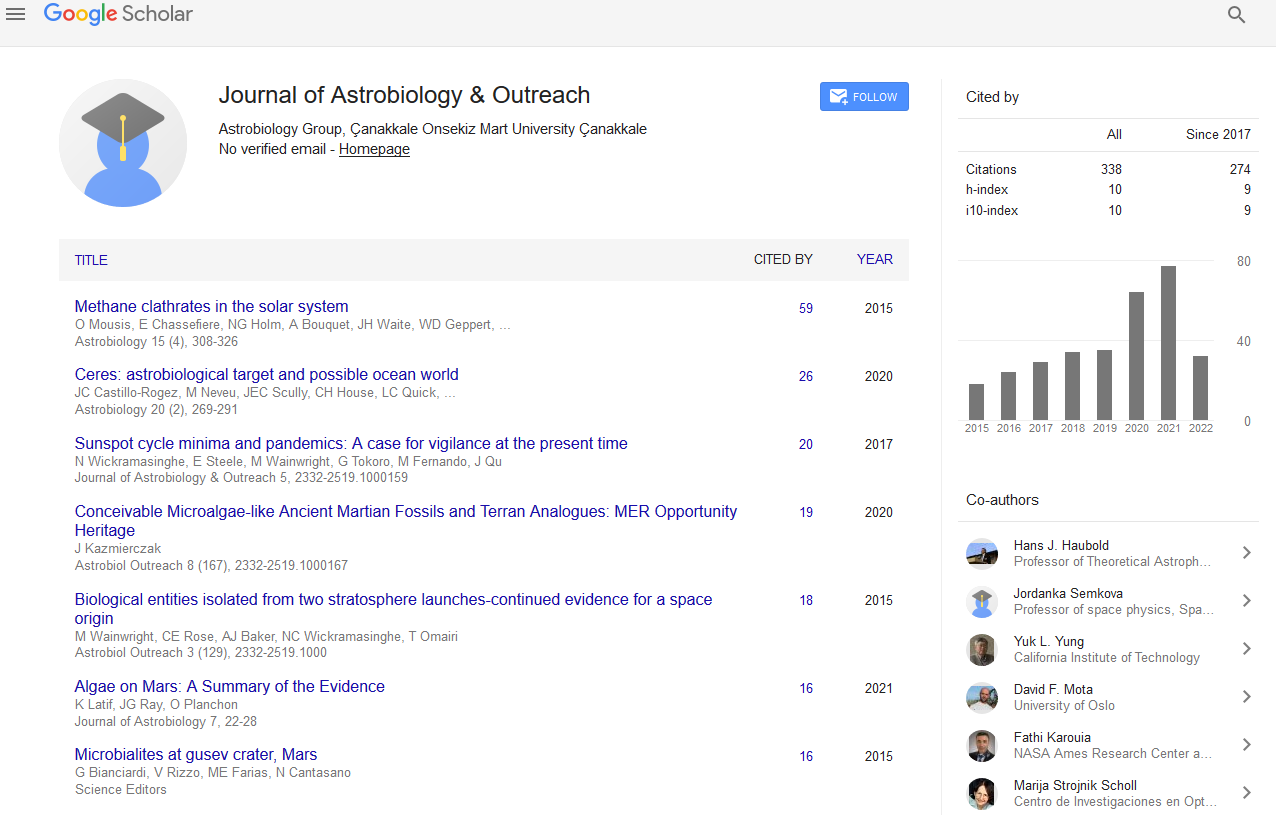Indexed In
- Open J Gate
- Academic Keys
- JournalTOCs
- RefSeek
- Hamdard University
- EBSCO A-Z
- OCLC- WorldCat
- Google Scholar
Useful Links
Share This Page
Journal Flyer

Open Access Journals
- Agri and Aquaculture
- Biochemistry
- Bioinformatics & Systems Biology
- Business & Management
- Chemistry
- Clinical Sciences
- Engineering
- Food & Nutrition
- General Science
- Genetics & Molecular Biology
- Immunology & Microbiology
- Medical Sciences
- Neuroscience & Psychology
- Nursing & Health Care
- Pharmaceutical Sciences
Perspective - (2023) Volume 11, Issue 5
Astronomical Incidents and Solar Storms: Handling Celestial Turbulence
Pasquale Blasi*Received: 22-Aug-2023, Manuscript No. JAO-23-24782; Editor assigned: 25-Aug-0005, Pre QC No. JAO-23-24782(PQ); Reviewed: 08-Sep-2023, QC No. JAO-23-24782; Revised: 15-Sep-2023, Manuscript No. JAO-23-24782(R); Published: 25-Sep-2023, DOI: 10.35248/2332-2519.23.11.316
Description
The cosmos, with its incredible quality, the universe is not always benign; it is a region of dynamic forces that can unleash celestial turbulence with remarkable intensity. Stellar incidents and solar storms, driven by the complex interplay of magnetic fields, gravitational forces, and nuclear processes, pose challenges and unexplainable for astronomers and space scientists.
Stellar incidents encompass a variety of unpredictable and often explosive events occurring on and around stars. One such incident is a supernova, the spectacular death throes of a massive star. During a supernova, the star undergoes a catastrophic collapse, resulting in a colossal explosion that outshines an entire galaxy for a brief period. Supernovae are essential cosmic events, responsible for dispersing heavy elements into space and influencing the formation of new stars and planetary systems.
Another type of stellar incident is a Gamma-Ray Burst (GRB), an extremely energetic and elusive phenomenon. GRBs release intense bursts of gamma-ray radiation, making them the most energetic events in the universe. Although the exact mechanisms behind GRBs are not fully understood, they are believed to be associated with the collapse of massive stars or the merging of neutron stars. Despite their rarity, these cosmic light provide astronomers with important information about the early universe and the processes controling stellar life cycles.
Closer to home, the sun, our life-giving star, is not immune to celestial turbulence. Solar storms, also known as space weather events, are eruptions of energy and charged particles from the sun's outer atmosphere. These storms can manifest in various forms, including solar flares, Coronal Mass Ejections (CMEs), and Solar Energetic Particle (SEP) events.
Solar flares are sudden and intense bursts of radiation, often accompanied by the release of energetic particles. These phenomena are linked to the sun's magnetic activity, with the most powerful flares capable of disrupting communication systems and navigation equipment on Earth. Coronal mass ejections, on the other hand, involve the expulsion of vast amounts of solar material into space. When directed towards Earth, CMEs can induce geomagnetic storms, affecting power grids and satellite operations.
Solar energetic particle events result in the acceleration of charged particles, primarily protons, by the sun's magnetic fields. These particles can pose risks to astronauts in space and affect satellite electronics. Understanding and predicting solar storms are critical for safeguarding both our technological infrastructure and the well-being of space-traveling humans.
Celestial turbulence, whether in the form of stellar incidents or solar storms, has tangible impacts on our planet and the technology we rely on. The electromagnetic radiation from stellar incidents, such as supernovae and gamma-ray bursts, can potentially affect Earth's atmosphere, leading to changes in ionization levels and influencing climate patterns.
Solar storms, with their charged particles and magnetic disturbances, can interfere with communication and navigation systems on Earth. Disruptions to satellite operations, GPS signals, and power grids can occur during severe space weather events. The potential economic and societal consequences of such disruptions highlight the importance of ongoing research and preparedness efforts to mitigate the impact of celestial turbulence.
In the case of solar storms, space agencies and research institutions deploy a fleet of satellites equipped with instruments to monitor the sun and its activity. The Solar and Heliospheric Observatory (SOHO) and the Solar Dynamics Observatory (SDO) are among the spacecraft dedicated to studying the sun's behavior and providing real-time data on solar storms. Groundbased observatories, such as the National Solar Observatory (NSO), complement space-based observations, offering a comprehensive view of solar activity.
One of the primary challenges in handling celestial turbulence is predicting the occurrence and severity of stellar incidents and solar storms. Scientists utilize sophisticated models and simulations to forecast space weather conditions, providing early warnings for potential impacts on Earth and space technology. These predictions are important for implementing preventive measures, such as temporarily shutting down vulnerable satellite systems or adjusting spacecraft trajectories to minimize the risk of damage.
Additionally, the development of advanced space weather monitoring systems and international collaborations enhance our ability to anticipate and respond to solar storms. Space agencies, including NASA and the European Space Agency (ESA), collaborate on space weather forecasting initiatives to share data, improve models, and strengthen our global capability to mitigate the impact of celestial turbulence.
Celestial turbulence, in the form of stellar incidents and solar storms, adds a layer of complexity to our exploration of the cosmos. While these phenomena pose challenges, they also provide unique opportunities to deepen our understanding of the universe's dynamic nature. Through continuous observation, research, and technological advancements, scientists strive to resolve the unexplainable of celestial turbulence and develop strategies to handle its impact on our planet and space technology.
Citation: Blasi P (2023) Astronomical Incidents and Solar Storms: Handling Celestial Turbulence. J Astrobiol Outreach. 11:316.
Copyright: © 2023 Blasi P. This is an open-access article distributed under the terms of the Creative Commons Attribution License, which permits unrestricted use, distribution, and reproduction in any medium, provided the original author and source are credited.

